Abstract
This paper reviews a state-of-the-art zero emission propulsion system for a battery-powered small craft. The main aspects considered are the available propulsion systems, energy storage, and dock battery charging. This underlying activity is part of the KISS project, a research and development program in the frame of the EU-funded “Piano Operativo Regionale CALABRIA FESR-FSE 2014–2020 ASSE I–PROMOZIONEDELLA RICERCA E DELL’INNOVAZIONE”, which is aimed at designing and building a physical prototype. Its hull form is based on previous research conducted by the authors, and the powering performances were preliminarily predicted by CFD simulation. The KISS project represents a successful example of an electric small craft with performances and a mission profile comparable to competitors with conventional propulsion. Such a target has been achieved by a concurrent design that considers the hull form, engine, propulsion system, and energy storage onboard. Safety issues and the regulatory frame are also highlighted.
1. Introduction
Sustainable development does not end in a series of rules and directives, but rather it is a continuous process made up of work and commitments to build a strategy that contributes to the well-being of the planet and its population. Recently, the concept of sustainability has been applied more specifically to living organisms and their ecosystems. With reference to society, sustainability means a “balance between satisfying present needs without compromising the ability of future generations to meet their own” as reported in the Brundtland Report of 1987 [1]. Clear scientific evidence has now emerged indicating that humanity is living in an unsustainable way, consuming the Earth’s limited natural resources faster than it is able to regenerate. Consequently, a collective social effort to adapt human’s consumption of these resources to a level of sustainable development is a matter of paramount importance for present and future of generations. Sustainability can be an idea, a lifestyle, and a way of producing at the same time. The KISS (Keep It Sustainable and Smart) project concerns the research, development, and design of a demonstrator small craft characterized by high sustainability in terms of energy and low harmfulness for people and the environment as well as by hydrodynamic performance and a load capacity suitable for both pleasure and professional use. In this last case, the vessel can be used as a ten passenger craft with navigation limits according to National Authorities’ regulations. KISS prototype development considers the characteristics of sustainability and low harmfulness in all phases of the product’s life, from the choice of raw materials, to production, use, and maintenance, up to disposal in coherence with an LCA (life cycle assessment) approach. This compliance, although not yet mandatory, is gaining increasing consideration in ship [2] and small craft construction, specifically with aspects related to fiberglass and composite structure disposal [3]. Significant results regarding sustainability with an adequate performance and potential of the mission profile can make subsequent production competitive within present and future scenarios of the sector.
A general interest in zero-emission shipping, in the frame of future global decarbonization targets, is perceived in the marine field. Perspectives, new hypothesis, and mid-term development directions are shown in [4,5]. A detailed identification of future trends is given in [6]. A mapping of zero emission pilots and demonstration projects are reported in [7].
Currently, zero-emission proposals are focused on two main vessel types:
- Commercial ships, mainly ro-ro ships, that operate in a zero-emission mode in the short-term while in a harbor or protected areas;
- Small passenger or pleasure crafts with limited range and speed that always operate at zero emission.
A most interesting report on electric ferries and ro-ros operating in the Baltic Sea, one of the areas that has pioneered the development of zero-emission shipping, can be found in [8].
The KISS project concerns small passenger or pleasure crafts powered by batteries with limited range and speed. The aim of this research and development was to obtain performances comparable to similar crafts powered by thermic engines. Several studies on this matter have been reported over the last years. The design aspects and typical characteristics of an electric small passenger craft operating as a service boat for a luxury hotel on Como Lake are reported in [9]. In this case, compact and light twin 80 kW PMSMs (permanent magnet synchronous motors) allow for a maximum speed of 24 knots, which is comparable with the similar diesel-powered craft operating on the lake. The range (1 h at top speed and 4 h at 10 knots) provided by a 180 kWh battery pack is adequate for daily service with a battery charge overnight. Elettra, the name of the vessel, has successfully been operating since the 2019 tourist season.
Working boats suitable for the different services requested in marine protected areas, such as patrolling, security, and maintenance, are mainly diesel-powered crafts. Only passenger transportation is conducted by crafts with zero-emission capabilities. A proposal for a multiservice, zero-emission electric boat with a specific SWATH hull form for low-wake wash is described in [10].
A complete reference for battery-operated small crafts in which all design aspects have been extensively considered is provided in [11].
A simulation model for a small zero-emission passenger craft operating in restricted areas is reported in [12]. The model combines the hydrodynamic issues of maneuvering and propulsion in restricted water as well as simulation of electric loads and the capacity of the energy storage system installed onboard in order to rapidly assess the green capabilities of the new projects during the early stages of design.
The design approach to battery-powered boats and two meaningful examples of small passenger crafts operating in Tokyo’s waterfront are described in [13].
In addition to the design’s technical aspects, in the evaluation of zero-emission’s main features and potential advantages, careful attention must be given to the mission profile’s identification and to the pros and cons of replacing existing vessels. Most important, the feasibility of zero-emission shipping is related to the availability of local energy and to the characteristics of the ships and routes. An investigation on this topic that can be used as a reference for any type of similar study is reported in [14]. Similar matters but limited only to nautical tourism can be found in [15].
A pilot study to verify the sustainability of inter-island transport, presented in [16], described a small electric boat with photovoltaic (PV) modules designed and field-tested in Samal Island, Philippines.
As already experienced in the automotive market, potential social and technical barriers handicap the adoption of the electric boat, mostly due to a lack of awareness and knowledge. In [17], some considerations that can help to consider consumer preferences in electric boat designs are reported.
The environmental and health impacts associated with using electric service vessels in the recreational boating industry are assessed in [18]. The study focused on pump-out boats that enable the sanitary management of human waste generated aboard recreational vessels, considered as a model of the whole recreational boating service sector. A life cycle assessment of electric and gasoline-powered pump-out boats revealed that electric boats have lower lifetime greenhouse gas emissions than their gasoline-powered equivalents, especially when electric boats are charged using renewable resources.
In the general interest of unmanned vessels, the options of zero-emission characteristics are considered in [19].
Solar energy is strictly related to zero-emission concepts. Energy provided by solar panels can be seen as a contribution to energy stored onboard as well as an energy source available for any other request from propulsion to lighting. In the case of ships, where a given amount of energy is always requested, due to the small relative quantities of electrical supply provided by solar panels, they can be directly connected to the utilities. More in general, solar panels charge battery packs that can store or act in the buffer mode.
As regards electric propulsion, available PV panel areas are generally not adequate to provide the whole amount of propulsion energy, although a few experimental vessels have performed successful long-range cruising. The most famous is the Solar Planet, which, in 2010–2012, sailed around the world powered by solar energy. Recently, the feasibility of solar-powered small craft has been explored as for the passenger craft shown in [20]. The key factors for such an achievement are a very low-resistance hull form and a mission profile compatible with very low cruising speed. A catamaran configuration was chosen for the large available area where the PV array was set, although not optimal for the considered low relative speed due to the fact of its higher wet surface and, consequently, large viscous resistance in comparison to an equivalent monohull.
Some examples of only solar-powered boats are reported in [21]. The characteristics of the best electrical components as well as the energy management from PV array to electric engine are described.
A two-step optimization design for solar-powered boats is presented in [22]. First, a simplified ship size optimization is considered; then, the optimization of the PV system’s size to obtain the number of photovoltaic modules and batteries with minimum cost is presented.
A further development of solar-boats has been designed by Universitas Indonesia’s team, which participated in the International Solar Boat Challenge competition held in the Netherlands in 2016 and presented in [23]. The research considers mechanical systems of the boat as one the most important things to make an efficient solar-powered boat.
As regards energy storage, small-sized, zero-emission craft are generally equipped with batteries. The use of hydrogen and fuel cells is considered a future option when distribution and cost will not be insurmountable obstacles as they are now. An extensive review of energy storage with special attention to battery characteristics is reported in [24].
The development of an algorithm for the basic design of a zero-emission small craft is described in [25]. It determines the optimal electric motor and battery specifications for the basic requirements and arranges electrical propulsion components using the center of gravity position as an objective function.
Several reports of financed zero emission projects are available, although only a few of them can be considered as scientific or technical contributions.
Numerical and experimental optimization of a fast zero-emission catamaran is reported in [26], which can be considered representative of the state of the art.
The conversion of existing ships and small crafts as an approach to zero emission is diffused, as presented in [27], although rarely successful.
The BBGREEN Project (“Battery powered Boats, providing Greening, Resistance reduction, Electric, Efficient and Novelty”) is interesting for the all-round approach to achieving sustainable navigation targets. A detailed report is given in [28].
Recently, in the frame of the H2020 funded project: “TrAM—Transport: Advanced and Modular” [29], further interesting contributions focused on transport solutions with a cost-effective and environmentally friendly life cycle are presented.
The study reported in [30] is focused on a battery-driven, zero-emission “TrAM London Demonstrator”, designed for the Thames River, London, UK. It examined the hydrodynamic performance of a preliminary design of this high-speed catamaran in shallow water and verified and validated the computational methods employed in the hydrodynamic optimization of the hull form. Although relative to a defined project, it can be useful as a general reference for small-sized catamaran hulls.
In [31], the design of a fast catamaran passenger ferry demonstrator, planned for operation as a waterborne shuttle in the Stavanger/Norway area, and of a replicator for operation in the Thames River, London, UK, are elaborated including infrastructural issues for their operation.
More in general, in [32] a concept for waterborne transport by implementing state-of-the-art “Industry 4.0” holistic ship design and production methods for fully electrical vessels operating in the vicinity of urban areas is validated, and further future R & D activities are presented. The aims of the project are significantly lower construction costs and a reduction in engineering hours for new zero-emission vessels. Three different catamarans will be designed implementing the developed methods, and one will be model tested, constructed, and operated in Norway.
2. Zero-Emission Small Craft
The aero-emission craft considered in this paper are defined as vessels that can operate at cruising speed without any gas or particle emissions and without appreciable noise emissions from engines and machinery. Figure 1 shows a synthesis of the main aspects to be considered in a zero0emission small craft project. An electric engine(s) powered by battery packs is the first and often the only choice when minimum environmental impact is a design request. Lithium batteries are, at present, the most used energy storage for zero emission. Hydrogen and fuel cells are a promising future, but they are now still limited to research programs due to the issues of space onboard, considerable weight, and most importantly, an ashore distribution net that still to be setup.
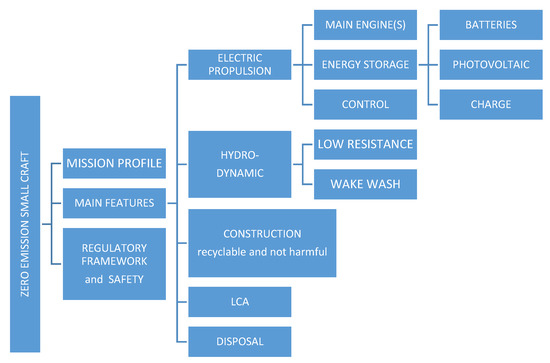
Figure 1.
Different aspects to be considered in a zero-emission small craft project based on battery energy storage.
Zero-emission characteristics are becoming mandatory for small boats or ships operating in sheltered or inland waters. Although the features and benefits of hybrid electric marine propulsion have been influencing ship design and meeting standard mission layouts and profiles, zero emission has been linked to lower performance and range due to the technological limitations and costs of onboard energy given by lithium batteries. Each aspect influencing the surrounding environment must to be taken into account, ship performances have to be ranked from different and new points of view, where comfort and safety are preferred in respect to speed. The first design step is a careful consideration of mission profiles best fitting typical aspects of zero-emission propulsion.
The main features of a zero-emission craft are described in the following paragraphs. A database of zero emission small craft on the market at present is shown in Table 1, for pleasure boats with length overall (LOA) from 6 to 8.5 m, and in Table 2 for passenger craft with LOA from 10 to 15 m. This LOA range was considered accordingly in the frame of the KISS prototype’s planned dimensions. The chosen examples were all equipped with lithium batteries as energy source.

Table 1.
Database of zero-emission small pleasure craft.

Table 2.
Database of zero emission small passenger craft.
3. Mission Profile
Once full, the electric propulsion is selected, and the requested range is limited by the available onboard energy storage. Short trips with stops adequate for quick recharging are key factors for a successful zero-emission project. Medium–low cruising speed can be close to those a thermal-engine-equipped competitors due to the high efficiency gained by AC (alternating current) brushless electric engines. Key factors, such as cruising speed, range, and duration of charging time, are counteracting. In this case, it is easy to identify non-dominated designs by simple MADM (multi-attribute decision making) procedures. The main limiting factor is the capacity of onboard energy storage, but currently the ashore charging capabilities are also a critical factor. Significant progress has been made to reduce the battery charging time, and together with this, the increase in horsepower has led to the request for large amounts of energy to be delivered in short periods of time. This is an important factor for improving mission profiles, but very seldom is an ashore electric distribution net able to satisfy requests in terms of time and energy density. Meaningful answers are proposed energy docks, where electric energy is stored in batteries at the end of their working life and no longer suitable for onboard service. They are charged slowly 24/7 by the existing electrical net and deliver quickly to onboard batteries during short stops. The first and most successful example is given by the Norwegian shipping company, The Fjords, Måløy, Norway, that has two purely electric ferries in service: the “Future of the Fjords” and its sister ship the “Legacy of the Fjords”. They are driven by two electric engines with an output of 450 kW each and can reach a maximum speed of approximately 16 knots. The energy is provided by a battery pack with a capacity of approximately 2000 kWh. They can use the charging facility installed in 2018, a floating dock station [33]. Solar energy can improve craft range through photovoltaic panels set on the top of the superstructure or hard tops. A target of unlimited range can be achieved as demonstrated by the world circumnavigation completed by Solar Planet in 2011 and the Atlantic crossing in 22 days in 2013. Solar Planet is a 31 m LOA catamaran and navigates without any CO2 emission; her electric engines are powered by 103 kW produced by 38,000 photovoltaic cells that cover the ship from bow to stern. Such astonishing results are obtained with extremely slender twin hulls and extreme limitations in external and internal layouts. Catamarans are evidently favored by the large sundeck area, in respect to monohulls, where available surfaces for photovoltaic cells are quite smaller. At present there is no unlimited range vessel of practical use, but there are some attempts using catamarans, where solar energy can assure a very low-speed propulsion, while monohull-set solar panels partially contribute to the “hotel”-like electrical energy needs.
4. Main Features of Zero-Emission Propulsion for Small Crafts
4.1. Main Engines
The first attempts at zero-emission small crafts were equipped with DC (direct current) engines. They were simple to install and to control and worked with safe low-voltage ranges, but they were heavy in relation to the delivered power. At present, DC engine applications for small craft marine propulsion are limited to 20–40 kW at 48–96 V. They are suitable for small crafts with low speed and, consequently, relatively low motion resistance. In some cases, as in the KISS project, DC engines are coupled in a series to obtain adequate horsepower.
To obtain 80 kW of power or more and better power/weight ratios, it is necessary to move to higher voltages and to AC engines. The best achieved power/weight ratio was approximately 1–1.2 kW/kg, consequently the engine dimensions were also very small. Commonly, used engines are brushless with almost no maintenance needed. Permanent Magnet Synchronous Motors, an AC synchronous motor in which the field excitation is provided by permanent magnets, is one of the most interesting types of AC electric motors available in the 80–200 kW range, and it is described in detail in [9]. It is possible to obtain engine rotational speed values similar to propellers when the constraints on the engine diameter are not too stiff. This allows a direct shaft connection without a gearbox. Often, electric motors, due to the fact of their small size, are housed in pods directly connected to the propeller. This setup needs no space inside the hull and allows easy cooling provided by surrounding water, but any leaks in the pod or any engine maintenance forces the ship to be dried at dock. For this reason, internal motors with a standard driveshaft and thrust bearing were chosen for the KISS project. The installation of twin engines was due to better maneuverability, safety, and easier installation thanks to the smaller engine size for the same total power required.
In Table 3, the technical characteristics of suitable engines are presented. The table is limited to inboard engines with dimensional and weight characteristics fitting the KISS prototype or any similar small craft.

Table 3.
Electric engines for small craft.
It is evident how the higher voltage leads to better performances but implies more difficulties in energy storage and current management.
4.2. Energy Storage
Energy storage onboard zero-emission marine vehicles can be provided by hydrogen and fuel cells or by batteries. The high energy density of liquid hydrogen tanks (1.3 kWh/L) compared to gaseous hydrogen tanks (0.36 kWh/L) and battery systems (~0.09 kWh/L) make liquid hydrogen systems the most capable of meeting different vessel sizes and mission requirements. Fuel cells offer a reliable and compact zero-emission generation. Their development may be crucial to complete the expansion of renewable technologies in the transportation sector. Fuel cells are much more complex in respect to lithium batteries. This can be observed in the electric circuits, cooling systems, and software codes that are needed. Additionally, the craft operator must guarantee the hydrogen supply.
Since the energy density of battery systems is less than 1/10 of that of liquid hydrogen, battery systems quickly become much larger than hydrogen systems, as the demand for stored energy increases. For this reason, long-range missions favor hydrogen fuel cell systems. As the flow rate increases, the energy component of the system increases. For fuel cell systems, the increase regards only the fuel tank; the fuel cell itself remains constant at the level needed for power. Due to the fact of their size, fuel cells have difficulties in fitting available spaces, while the battery system does not. Fuel cells are better suited for large ships and lithium-based batteries for small vessels with high speed/length ratios. The technical characteristics and mutual advantages of the lithium batteries and fuel cells are presented and evaluated in [34].
4.2.1. Batteries
There are various types of batteries with different electrical capacities, different chemical compositions, shapes, and sizes. For small craft applications, the following types are used:
- AGM battery (absorbent glass mat): batteries in which the electrolyte is a mixture of water and sulphuric acid absorbed by fiberglass elements. They are maintenance-free and normally do not produce gas. They can be located anywhere on board, and forced ventilation is usually not necessary. Thanks to their structure, AGM batteries can be discharged quickly, and they are suitable for systems where high current peaks are required, i.e., engine start up;
- Gel batteries: batteries where the electrolyte is absorbed in a gel. They are maintenance-free and do not produce gas. Since forced ventilation is not normally required, gel batteries can be located anywhere on the boat. They are ideal as service batteries and for cyclic use and recharge very quickly;
- Lithium-ion batteries: batteries that have a high energy density and guarantee savings of up to 70% in weight and dimensions compared to traditional lead-acid batteries. They are perfect for cyclic applications, being able to withstand more than 2000 deep discharge cycles (80%) and store five times more energy over their life cycle than lead-acid batteries. Battery technology is improving rapidly and is predicted to become more mass and volume efficient in the coming years. Currently, for shipboard propulsion, Li-ion batteries offer the highest energy density, a suitable power density, high efficiency, and an acceptable lifetime.
The family of lithium batteries is vast, and the electro-chemistry can be tailored for specific need. Some types offer high energy density or high power density; some others have superior thermal stability for fast charging and discharging but offer lower capacity, typically 50–70 Wh/kg. Battery characteristics are reported in detail in [24].
Lithium batteries need a durable, waterproof case and a battery management system (BMS). A BMS guarantees the optimal use of each single cell, even during fast discharges and recharges, and it incorporates the parameter monitor to always have the battery status under control. A BMS has to deal with a battery charger to optimize the charging process and extend the life of the battery itself. The cost of lithium batteries remains high. Moreover, they are limited in life cycle so that they must be replaced several times during a ship’s working life.
Type, size, and technical characteristics of the accumulators are connected to a propulsion engine’s characteristics and to the required range. AC high power electric motors have proven to be quite successful for propulsion, but they need AC tensions on the order of 400–600 V with consequently larger difficulties in managing energy storage and conversion with DC current negatively affecting the final result. High voltage batteries present several problems from high working temperature to preheating and to complex charge management, but they are the only choice if performance is requested. Inverters are heavy and bulky. A general trend is to use DC current with low tension, generally 48 V, sometimes 96 V for small horsepower, go to use an AC current with higher tension when speed is an important design feature.
The research and development on lithium batteries is mostly focused on automotive that need a flat rectangular shape with reduced thickness, as the battery has to be set below the passenger accommodation area. This shape is not suitable for small crafts, such as for the considered KISS program, where compact parallelepiped batteries with main dimensions less than 1 m are preferable. This factor has limited the possible battery choice.
Energy storage onboard is, at the moment, the weak point in the chain when developing a zero-emission small craft. For lithium batteries, the most interesting aspect for the presented project, the influencing factors to be optimized in the selection of the battery are:
- Density of energy for a weight unit ranging from 50 to 260 Wh/kg;
- Density of energy for a volume ranging from 250 to 670 Wh/L;
- Life of the battery (number of cycles) ranging from 500 to 1500;
- Disposal at the end of the working life;
- Intrinsic efficiency of the charge–discharge ranging from 80% to 90%;
- Depth of discharge (DOD) ranging from 80 to 90.
The two last characteristics are responsible for a significant difference between the quantity of energy that the battery can deliver and the energy that has to be stored aboard. This means that approximately 20–25% of the battery’s weight is carried onboard without any direct benefit for the performances.
4.2.2. Charge
Battery charging is, at present, a critical aspect in the use of any vessel with zero-emission capabilities. Hybrid vessels can rely on electric engines used as alternators when thermic engines are used, but full zero-emission small crafts, if not equipped with generators, as in the case of the KISS prototype, can only use ashore facilities. Photo voltaic contributions are marginal for propulsion needs. Considerable amounts of electricity have to be supplied from shore in a short time, as the battery charging time has been reduced by recent technical advances. The availability of the requested energy flow, at a single point, is a critical issue for the exploitation of fully electric marine vessels. For this, the most challenging programs concerning fully electric zero-emission crafts have developed a specific setup such as the one mentioned above—the Norwegian shipping company’s, The Fjords, Måløy, Norway [33]. As the local network does not have the capacity to charge the ship on the quay, a new charging solution called PowerDock has been implemented. It is a 40 m long and 5 m wide fiberglass floating dock located in the water in Gudvangen, which houses a 2.4 MWh battery pack. This is charged constantly throughout the day via a connection to the local network. This innovative solution allows the ship to “recharge” in a stable, efficient, and economical way in just 20 min. Ashore installations of standard automotive charging columns, (400 V three-phase with power up to 40 kW) on the docking piers are becoming a familiar view on the Italian Como Lake, Lombardy, Italy, where small electric crafts can benefit from the program “Electric Lake of Europe”. The development of this distribution net tailored to the needs of zero-emission crafts is crucial for diffusion as well as for cold ironing programs for emission reductions in large commercial ports.
5. Hydrodynamic Issues Related to the Zero-Emission Mode
The hull form design of fully electric small crafts is influenced by the small amount of available horsepower and, when navigation in MPA is considered in the mission profile, by the low hydrodynamic impact of the hull (i.e., wake wash), which ensures maximum protection for the marine environment. This means that motion resistance has to be reduced as much as possible with particular consideration for the wave component. The viscous resistance does not influence the environment but contributes to motion resistance and to installed horsepower. The wave resistance depends on the geometry of the hull form and on the dynamic characteristics. The effects of the slenderness of the hull and of the waterplane shape on the wave pattern have been known in navigation since ancient times. In the case of a small passenger crafts, an adequate slenderness ratio is limited by the transversal stability requested by the regulatory framework.
In this frame, catamarans are the best choice, as they combine very slender twin hulls with large deck areas, but within the KISS program, the capability to operate in crowded marinas is one of the main requests, so that a monohull is the only possible choice. A small craft at a practical cruising speed has a medium–high relative speed. This leads to considering planing and semi-displacement hull forms. To obtain a lower resistance, one must be able to obtain hydrodynamic lift at the lowest possible speed. Research results on semi-displacement hull optimization are reported in [35,36,37,38]; they are mainly experimental and the results in the form of regression formulas are very useful at a preliminary design stage and highlight the effect of hull geometry and CG position.
The geometric characteristics that influence wave resistance are slenderness of the hull (V/0.01L3), waterline angle in the bow, and block coefficient (CB). Each of them must be minimized as much as possible. The longitudinal position of the center of buoyancy (LCB) is also important, and useful indications are provided by available tank test results. Since 2005, intense work has been carried out at the University of Naples Federico II, Naples, Italy, for the design and development of non-monohedral hull shapes, with better hydrodynamic performances than standard monohedral ones [39], and in recent years, research has focused on hull shapes with low hydrodynamic drag capable of taking benefit from hydrodynamic lift at low relative speed [40,41]. Such hull forms are suitable for the KISS project prototype presented in this paper. The typical resistance hump trend of any planing boat is faired by the high lift provided by the stern sections with low deadrise and by a small bow trim at rest. Interceptor or stern flaps can be useful to obtain the best ride attitude and to adapt to the load conditions and the position of the passengers. In this frame, a light structural weight is very important to achieve hydrodynamic balance at the lowest possible speed.
6. Construction
If zero-emission capabilities are an outstanding aspect of the LCA (life cycle assessment), a sustainable construction is also important. It is connected to materials, technologies, and disposal at the end of the ship’s working life. The wider interest given to light alloys and the renewed interest toward wood construction are due to the complete fitting of such materials to the mentioned expectations. Unfortunately, they are not suitable for serial production of small crafts at competitive cost. The only possible choice for the KISS program and, more in general, to improve the sustainability of the GRP and FRP construction, widely diffused in the small craft and pleasure boat industry, is to consider recently developed alternative materials and technologies for a low environmental impact production, such as natural fibers, low toxicity resins, and contactless impregnation technologies.
7. Regulatory Framework and Safety of Zero-Emission Small Craft
Any type of marine vessel has to comply with a regulatory frame. Electric main engines are considered by classification societies and by ISO rules that have general validity. Pertinent ISO rules are:
- ISO 10133 for direct current system installations that operate at a rated voltage not exceeding 50 V;
- ISO 13297 for single-phase alternating current installations that operate at a rated voltage not exceeding 250 V;
- IEC 60092-507 (Ed. 2000) for three-phase alternating current systems that operate at a rated voltage not exceeding 500 V.
The favorable consideration of 48 V DC choice is enhanced by the application of the less stringent ISO normative. Recently, in the frame of the European Directive for Pleasure Craft 2013/53, the ISO 16315 Small craft—Electric Propulsion Systems was issued. This Regulation clarifies most of the design and installation aspects related to full electric propulsion on small crafts.
Additional class notations specific for zero-emission small crafts have been considered by some classification societies. The RINA Green Plus certification, issued in 2008 and updated every year, is an additional class certification assigned by RINA Services SpA, Genoa, Italy, to ships that have significantly invested in various technical, design, equipment, and operating procedure solutions capable of reducing the environmental impact, bringing the total emissions of pollutants well below the maximum limit required by current national legislation. The rule was revised in 2012 to cover new emissions on long-distance vessels and those operating at a fixed location. Since this additional and voluntary certification is based on a score, it was appropriate to introduce the so-called “Environmental Ship Index” (ESI), which has a value that will be significant for the award of the Green Plus.
The benefits given by RINA Green Plus can be summarized as follows:
- For the builder: Great flexibility in design choices and the possibility of introducing highly innovative technologies;
- For the customer/shipowner: Great added value given by a prestigious environmental certification; savings on operating costs thanks to the adoption of consumption reduction solutions;
- For the passengers: The guarantee of sailing on an environmentally friendly yacht, within additional class notation.
The BV (Bureau Veritas) considers an electric hybrid with complementary ZE notation when the zero-emission mode is available. ZE notation is based on ESS (electric energy storage system), as zero-emission mode is defined as the mode where ESS is temporarily the only source of power connected to electrical network. This mode allows to stop all main generator sets and the associated emissions of exhaust gases.
Safety issues specific to zero-emission small crafts are related to the presence of relatively high electric tension onboard small crafts and the behavior of lithium batteries in the case of fire, damage, or sinking. Emergency engine stop is mandatory according to ISO 16315. Electric plant features on board small crafts are quite well described by the previously mentioned ISO rules, but risk assessment evaluation relative to lithium batteries is not yet defined due to the uncertainties in their behavior in the case of a fire. As regards to sinking, batteries are contained in watertight IP 67 boxes. In the case of a fire, the currently considered countermeasure is the flooding of the battery compartment to avoid overheating and potential explosion of the batteries. Such action implies adequate means and careful consideration of stability issues. No official solution has yet been proposed by international rules to solve the problem of overheating the battery packs in case of a fire.
8. KISS Program
The KISS project concerns the research, development, and executive design of a prototype of a battery-powered electric boat hull characterized by high sustainability in energy terms and low harmfulness towards people and environment with (high) hydrodynamic performances and load capacity suitable for both pleasure and professional use. The characteristics of sustainability and low harmfulness are considered for all phases of the product’s life from the choice of raw materials, to production, use and maintenance, up to disposal.
Unlike other programs proposed in this sector, in which only some aspects of working life are considered and low performance are obtained, the KISS project proposes an overall approach that supports competitive research and development. The authors believe that this is the only way to achieve both significant results from the point of view of sustainability and, at the same time, performance and the potential of the mission profile so as to make subsequent production competitive in present and future scenarios in the sector.
In the following paragraphs the main features of the KISS project are reported and summarized in Figure 2.
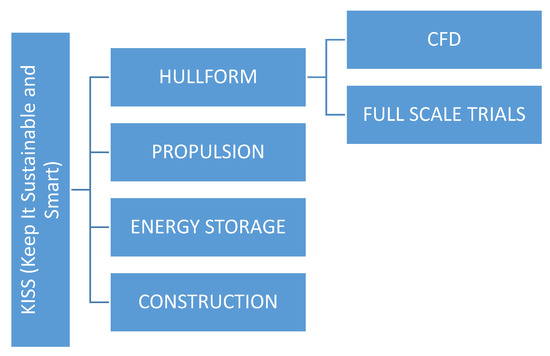
Figure 2.
The main steps of the KISS program’s development.
8.1. Hull Form
According to the typical aspects of hull forms suitable for the zero-emission small crafts considered previously in Section 5, a low drag form optimized for a semi-displacement regime (Fr 0.4–0.6) was chosen with reference to the lines and experimental tests reported in [40]. In the KISS project, towing tank tests were considered only as a general reference for the initial design. This hull form was considered to be quite suitable for the KISS prototype that is characterized by a very low installed horsepower due to the limited range of the 48 V DC engines that were a design constraint for safety, cost, and easy installation. A hard chine was chosen to increase the initial stability. This is coherent with the KISS prototype’s aims and will improve passenger comfort at low and zero speed. Figure 3 and Figure 4 show the lines and transversal sections of the tested low drag hull form. Figure 5 illustrates the scale model tested in the Naples’ towing tank at Fr = 0.5 without interceptors, and Figure 6 shows how the transom interceptors were set. Details can be found in [40]. Table 4 reports the geometrical characteristics of the KISS prototype hull.
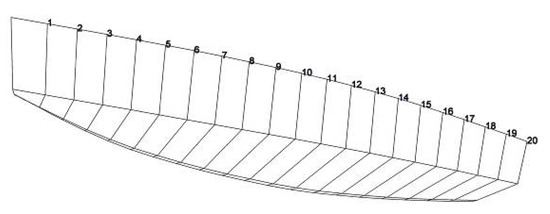
Figure 3.
Lines of the tested low drag hull form.
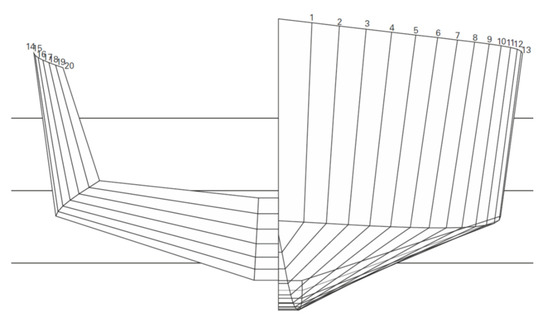
Figure 4.
Transversal section of the tested low drag hull form.
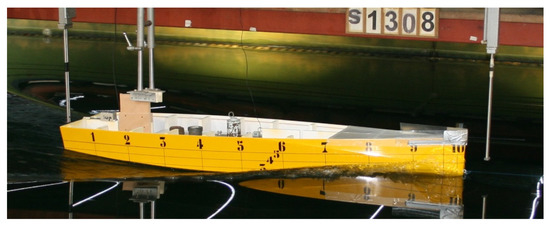
Figure 5.
Scale model at Fr = 0.5 tested in the Naples’ towing tank.
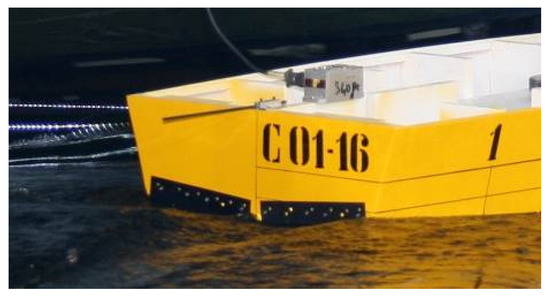
Figure 6.
Detail of interceptors applied to the scale model tested in the Naples’ towing tank.

Table 4.
Geometrical characteristics of the KISS prototype hull.
Figure 7, Figure 8 and Figure 9 represent the evolution of the original hull form to a first hypothesis with a short bow overhang, the modified trend of the forebody, and of the forward part of the hard chine to the final solution with the bow modified for marketing needs to follow the family line of Cantieri Guarascio shipyard. No modifications were. performed on the afterbody. Due to the mentioned modifications, towing tank tests were considered only as a general reference for the initial hull form.

Figure 7.
The KISS prototype’s hull form development.

Figure 8.
The KISS prototype’s first hull form with a modified bow and forebody.
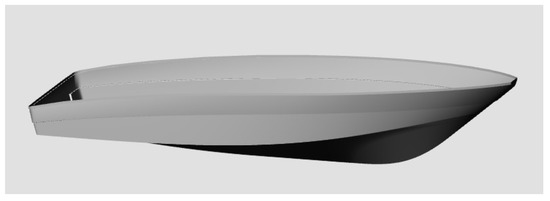
Figure 9.
The final hull form of the KISS prototype.
The assessment of the motion resistance was conducted by CFD simulation, and the results are reported in Section 8.2.
8.2. Speed Predictions via CFD Analysis
Computational fluid dynamics represents a flexible tool to assists designer in the early stage of design. It is important to underline that many critical issues arise when using CFD on planing/semiplaning hulls as they did in the KISS project. Planing crafts behave completely different from displacement hulls because of the important role the dynamic pressure field has on the hull’s balance. The dynamic pressure strongly affects dynamic trim and, consequently, the hull’s resistance, making numerical solutions to fluid dynamic problems more complex, as reported in [42], where a complete validation and verification (V & V) procedure carried out on planing hulls is presented, highlighting the limits of CFD techniques in the prediction of planing hull performances. For the current analysis, U-RANS (unsteady Reynolds-averaged Navier Stokes) simulations were performed following the indications of the ITTC 2014 [43] through the commercial code Star CCM+. To improve the convergence of results the acceleration ramp was set to 1 s; the degrees of freedom of the hull, sinkage and trim, were released after 3 s of simulation; the initial position of the hull was predetermined through the Savitsky method. Boat speeds of 10, 13, and 16 kn with and without interceptors were analyzed.
Results
Table 5 shows the results in terms of bare hull resistance and effective power. The data show a quite large dynamic trim. For this reason, the use of an interceptor was considered. An interceptor is a vertical blade protruding a few millimeters from the transom. It generates a considerable amount of concentrated lift at the cost of a very small increase in motion resistance. The effect of interceptor is not only to reduce the dynamic trim, but also to increment the dynamic lift as can be seen from the rise in the center of gravity (CG Rise) in the two different configurations. The dimension of the interceptor was set at 0.25% of the waterline’s length, as suggested in [44], for the considered speeds and dimensions.

Table 5.
Hydrodynamic properties of the bare hull and of the hull with the interceptor at displacement = 3650 kg.
To clarify the effect of interceptors, the dynamic pressure field was evaluated around the hull as shown in Figure 10a,b and Figure 11a,b for a 16 kn test simulation without and with an interceptor, respectively. It is easy to notice the significant effect of this device in terms of increasing pressure on the stern and consequent magnification of the lift, reduction in trim, and finally reduction in resistance.
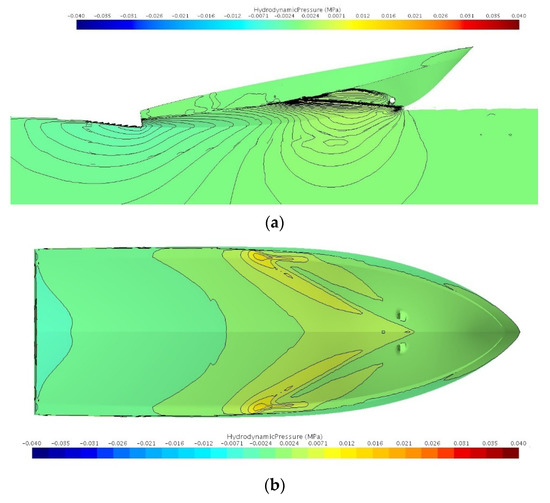
Figure 10.
(a) Dynamic pressure field around the hull without interceptors, longitudinal view. (b) Dynamic pressure field around the hull without interceptors, bottom view.
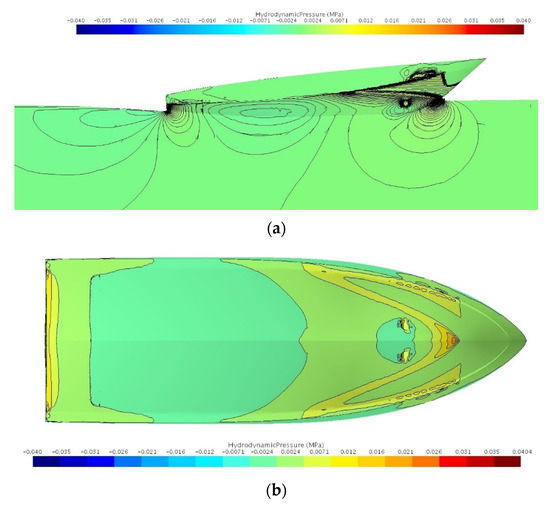
Figure 11.
(a) Dynamic pressure field around the hull with interceptors, longitudinal view. (b) Dynamic pressure field around the hull with interceptors, bottom view.
8.3. Propulsion
The choice of the propulsion system was a low-voltage DC for safety, lower costs, and easy installation and maintenance, although this limited the installed brake horsepower. The manufacturer that best met these criteria was Oceanvolt, which offers hybrid or electric 48 V DC systems. The choice of Oceanvolt was due to the fact that their modular engine was available in four power configurations: 10, 20, 30, or 40 kW [45]. This allowed to consider future higher repowering with the addition of one 10 kW modulus. The KISS prototype was equipped with twin electric motor Oceanvolt AXC 30 kW including an engine management system, control display, operating levers, and wiring. The engine setup is shown in Figure 12. The engines were chosen according to the powering predictions reported in Results. considering a cruising speed of 10 kn and a maximum speed of 13 kn. A further advantage of the AXC 30 engine is the 1300 maximum revolutions per minute that allows for direct propeller coupling. The weight of each engine is 128 kg, and the dimensions are 399 × 443 × 747 mm.

Figure 12.
Electric engine and propeller shaft installation.
8.4. Energy Storage
The batteries chosen during the project’s configuration were two Oceanvolt/Cleantron 48 V type with 1.9 kWh modules, 1.9 kWh each [46] for a total energy of 30.4 kWh. This energy storage, considering the efficiency chain and 0.2 DOD value, allows for a range of 45′ at a maximum speed of 13 kn and 2 h 30′ at 6.5 kn.
8.5. Construction
Single pieces reinforced with linen fibers, biaxial and monoaxial impregnated with polyester isophtalic styrene-free resin by infusion with a vacuum bag, were used for hull and deck structures. This process assures almost no contact between active resin and workers and constant impregnation. It results in uniform and reliable laminate mechanical and elastic characteristics. The chosen materials are the most advanced choice in terms of sustainable construction for serial production of small crafts. Linen fibers are natural and, at present very easily disposal compared with glass fibers. While for conventional materials, reference can be made to ISO 12215 and to construction rules by classification societies, it is impossible to make an analytical prediction for natural fibers due to the lack of data. For these reasons, a set of specimens representative of the used laminates was prepared and tested according to ASTM D3039 standards. Once the elastic modulus of the stress–deformation ratio was defined, a nonlinear behavior was detected. The stresses were not proportional to the deformation: the values of the mechanical and elastic characteristics were 41.9 MPa for the ultimate tensile strength and 5.9 GPa for the Young’s modulus (E). These values are comparable with a low fiber content glass-reinforced plastic laminate and can be of practical use for pleasure and work boats, if the speed and consequent hydrodynamic pressure are low. Figure 13 shows the used equipment and the obtained results.
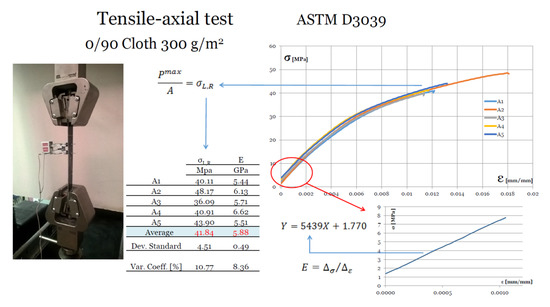
Figure 13.
Tensile-axial test according to ASTM D3039 of biaxial linen-reinforced composite.
9. Discussion and Conclusions
The paper reports a review focused on battery-powered small crafts in the frame of zero-emission shipping. Design aspects were considered and reports of successful R & D programs were mentioned. This is the first step in the KISS program aimed at designing and building a prototype of a zero-emission small craft suitable for both pleasure and passenger transportation. This activity is supported by EU co-funding and is a great opportunity for small companies in the marine field to update their own brands with sustainable features that represent most important market requests. The presence of scientific and professional partners contributes to providing know-how and helps to tailor targets to builder resources.
Propulsion and energy storage were described, and the sustainability frame of the prototype and further serial production was extended to the whole LCA and construction process using natural fibers for composite reinforcement. It appears feasible for small crafts to be built in serial production. An eco-friendly resin and contactless impregnation for the composite production complete the picture.
The small dimensions, the monohull configuration, and the open external layout do not allow for considering a significant PV energy contribution, which has potential and limits that were highlighted in the introduction.
The KISS program has proved to be successful because the prototype’s performances allows to consider its serial production; it will be part of the builder family line and the first model able to navigate in full zero-emission silent mode.
Figure 14 shows the KISS prototype, named Electra, exiting silently from the harbor of Lamezia Terme (Italy) without any emissions, and it synthesizes the results of the KISS program.
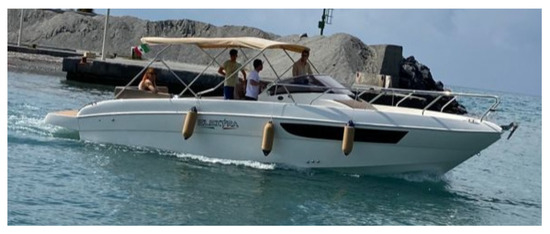
Figure 14.
KISS prototype in the zero-emission mode.
Author Contributions
Conceptualization, C.B. and E.B.; methodology, C.B.; software, F.D.L.; validation, F.D.L., C.B. and E.B.; writing—original draft preparation, C.B.; writing—review and editing, B.R.; visualization, funding acquisition, C.B. All authors have read and agreed to the published version of the manuscript.
Funding
This research was funded by POR CALABRIA FESR-FSE 2014–2020 ASSE I–PROMOZIONEDELLA RICERCA EDELL’INNOVAZIONE—Obiettivo specifico 1.2 “Rafforzamento del sistema innovativo regionale e nazionale”—Azione 1.2.2 “Supporto alla realizzazione di progetti complessi di attività di ricerca e sviluppo su poche aree tematiche di rilievo e all’applicazione di soluzioni tecnologiche funzionali alla realizzazione delle strategie di S3”.
Informed Consent Statement
Not applicable.
Acknowledgments
The authors acknowledge the support given by Cantieri Guarascio S.r.l. with special thanks to Andrea, Claudio, and Mirco Guarascio.
Conflicts of Interest
The authors declare no conflict of interest.
References
- Report of the World Commission on Environment and Development: Our Common Future Transmitted to the General Assembly of UN as an Annex to Document A/42/427—Development and International Cooperation: Environment. 1987. Available online: https://www.are.admin.ch/are/it/home/media-e-pubblicazioni/pubblicazioni/sviluppo-sostenibile/brundtland-report.html (accessed on 10 September 2021).
- Shama, M.A. Life cycle assessment of ships. Maritime Transportation and Exploitation of Ocean and Coastal Resources. In Proceedings of the 11th International Congress of the International Maritime Association of the Mediterranean, Lisbon, Portugal, 26–30 September 2005; Guedes Soares, C., Garbatov, Y., Fonseca, N., Eds.; Taylor & Francis Group: London, UK, 2005. ISBN 0-415-39036-2. [Google Scholar]
- Birmingham, R.W.; Landamore, M.J.; Wright, P.N.H.; Downie, M.J. Investigation of sustainable technologies for the design, construction, operation and decommissioning of recreational craft. In Proceedings of the 19th International HISWA Symposium on Yacht Design and Yacht Construction, Amsterdam, The Netherland, 13–14 November 2006; pp. 35–48. [Google Scholar]
- Strategic Research and Innovation Agenda for the Partnership on Zero-Emission Waterborne Transport. Technical Platform: Waterborne, June 2021. Available online: https://www.waterborne.eu/images/210601_SRIA_Zero_Emission_Waterborne_Transport_1.2_final_web_low.pdf (accessed on 30 November 2021).
- A Zero Emission Blueprint for Shipping. International Chamber of Shipping in collaboration with Ricardo, November 2021. Available online: https://www.ics-shipping.org/wp-content/uploads/2021/11/A-zero-emission-blueprint-for-shipping.pdf (accessed on 30 November 2021).
- Mestemaker, B.; van den Heuvel, H.; Gonçalves Castro, B. Designing the Zero Emission Vessels of the Future: Technologic, Economic and Environmental Aspects. Int. Shipbuild. Prog. 2020, 67, 5–31. [Google Scholar] [CrossRef]
- Fahnestock, J.; Bingham, C. Mapping of Zero Emission Pilots and Demonstration Projects, 2nd ed.; Getting to Zero Coalition: Copenhagen, Denmark, 2021. [Google Scholar]
- Kozian, T.; John, A. Electric Ferries in the Baltic Sea Region, Compendium; BSR Electric, ATI Küste GmbH—Gesellschaft für Technologie und Innovation (Association for Technology and Innovation): Rostock, Germany, 2020. [Google Scholar]
- Begovic, E.; Bertorello, C. Full Electric Work Boat. In Proceedings of the 12th Symposium on High-Performance Marine Vehicles HIPER’20 Cortona, Hamburg, Germany, 12–14 October 2020; pp. 333–444, ISBN 978-3-89220-718-4. [Google Scholar]
- Begovic, E.; Bertorello, C. Zero Emission Sustainable Craft for Coastal Marine Protected Areas. In Proceedings of the Convegno Annuale Internazionale AEIT 2016 108.a Edizione—Capri, Naples, Italy, 5–7 October 2016. [Google Scholar]
- Papanikolaou, A.D. Review of the Design and Technology Challenges of Zero-Emission Battery-Driven Fast Marine Vehicles. J. Mar. Sci. Eng. 2020, 8, 941. [Google Scholar] [CrossRef]
- Mauro, F.; la Monaca, U.; Marinò, A.; Bucci, V. A Simulation Model for a Hybrid-Electric Craft in Restricted Waters. J. Adv. Trans. 2020, 8, 941. [Google Scholar] [CrossRef]
- Umeda, A.; Shimizu, E.; Oode, T. Design strategy of Battery Powered Boat and its evaluation. In Proceedings of the Twenty-fifth International Ocean and Polar Engineering Conference Kona, Big Island, HI, USA, 21–26 June 2015; pp. 911–917. [Google Scholar]
- Sundvor, I.; Thorne, R.Y.; Danebergs, J.; Aarskog, F.; Weber, C. Estimating the replacement potential of Norwegian high-speed passenger vessels with zero-emission solutions. Transp. Res. Part D Transp. Environ. 2021, 99, 103019. [Google Scholar] [CrossRef]
- Łapko, A. The Use of Auxiliary Electric Motors in Boats and Sustainable Development of Nautical Tourism—Cost Analysis, the Advantages and Disadvantages of Applied Solutions. Transp. Res. Procedia 2016, 16, 323–328. [Google Scholar] [CrossRef]
- Palconit, E.V.; Abundo, M.L.S. Electric Ferry Ecosystem for Sustainable Inter-Island Transport in Philippines: A Pilot Study. Eng. Technol. Appl. Sci. Res. 2018, 8, 3570–3575. [Google Scholar] [CrossRef]
- Tveitdal, T. Market Barriers towards Electric Boat. Department of Design Norwegian University of Science and Technology. Available online: https://www.ntnu.edu/documents/139799/1279149990/33+Article+Final_trulstv_fors%C3%B8k_2017-12-07-17-25-18_TPD4505+Truls+Tveitdal.pdf/4523bd20-1024-4179-8dde-878d847a7e29 (accessed on 30 November 2021).
- Hemez, C.; Chiu, J.; Ryan, E.C.; Sun, J.; Dubrow, R.; Pascucilla, M. Environmental and health impacts of electric service vessels in the recreational boating industry. Water Pract. Technol. 2020, 15, 781–796. [Google Scholar] [CrossRef]
- Zero-Emission Autonomous Ferries for Urban Water Transport: Cheaper, Cleaner Alternative to Bridges and Manned Vessels. IEEE Electrif. Mag. 2019, 7, 32–45. [CrossRef]
- Spagnolo, G.S.; Papalillo, D.; Martocchia, A.; Makary, G. Solar-Electric Boat. J. Transp. Technol. 2012, 2, 144–149. [Google Scholar] [CrossRef]
- Kurniawan, A. A Review of Solar-Powered Boat Development. IPTEK J. Technol. Sci. 2016, 27, 1. [Google Scholar] [CrossRef]
- Nasirudin, A.; Chao, R.; Utama, I.K.A.P. Solar Powered Boat Design Optimization. Procedia Eng. 2017, 194, 260–267. [Google Scholar] [CrossRef]
- Sunaryo; Nurachman, D.; Imfianto, P.S. Design and calculation of mechanical system for solar-powered electric boat. In Proceedings of the 2nd International Tropical Renewable Energy Conference (i-TREC), Bali, Indonesia, 3–4 October 2017. IOP Conference Series: Earth and Environmental Science Corpus ID: 134425116. [Google Scholar] [CrossRef]
- Mutarraf, M.U.; Terriche, Y.; Niazi, K.A.K.; Vasquez, J.C.; Guerrero, J.M. Energy Storage Systems for Shipboard Microgrids—A Review. Energies 2018, 11, 3492. [Google Scholar] [CrossRef]
- Lee, D.K.; Jeong, Y.K.; Shin, J.G.; Oh, D.K. Optimized design of electric propulsion system for small crafts using the differential evolution algorithm. Int. J. Precis. Eng. Manuf.-Green Tech. 2014, 1, 229–240. [Google Scholar] [CrossRef][Green Version]
- Papanikolaou, A.; Xing-Kaeding, Y.; Strobel, J.; Kanellopoulou, A.; Zaraphonitis, G.; Tolo, E. Numerical and Experimental Optimization Study on a Fast, Zero Emission Catamaran. J. Mar. Sci. Eng. 2020, 8, 657. [Google Scholar] [CrossRef]
- Caprara, G.; Martirano, L.; Balletta, C. Preliminary Analysis of the Conversion of a Leisure Boat into a Battery Electric Vehicle (BEV). In Proceedings of the 2020 IEEE International Conference on Environment and Electrical Engineering and 2020 IEEE Industrial and Commercial Power Systems Europe (EEEIC/I&CPS Europe), Madrid, Spain, 9–12 June 2020; pp. 1–6. [Google Scholar]
- Surface Effect Ships Europe As. Final Report Summary—BB GREEN (Battery Powered Boats, Providing Greening, Resistance Reduction, Electric, Efficient and Novelty). 2015. Available online: https://cordis.europa.eu/project/id/234124/reporting/it (accessed on 16 December 2021).
- European Union’s Horizon2020 Research and Innovation Programme. TrAM—Transport: Advanced and Modular. 2020. Available online: https://tramproject.eu/ (accessed on 16 December 2021).
- Shi, G.; Priftis, A.; Xing-Kaeding, Y.; Boulougouris, E.; Papanikolaou, A.D.; Wang, H.; Symonds, G. Numerical investigation of the full-scale resistance of a zero-emission fast catamaran in shallow water. J. Mar. Sci. Eng. 2021, 9, 563. [Google Scholar] [CrossRef]
- Boulougouris, E.; Papanikolaou, A.; Dahle, M.; Tolo, E.; Xing-Kaeding, Y.; Jürgenhake, C.; Seidenberg, T.; Sachs, C.; Brown, G.; Jenset, F. Implementation of Zero Emission Fast Short sea Shipping. In Proceedings of the SNAME Maritime Convention, SMC2021, Providence, RI, USA, 25–29 October 2021. [Google Scholar]
- Boulougouris, E.; Priftis, A.; Mikal Dahle, M.; Tolo, E.; Papanikolaou, A.; Jürgenhake, C.; Svendsen, T.; Bjelland, M.; Kanellopoulou, A.; Xing-Kaeding, Y.; et al. TrAM—Transport: Advanced and Modular. In Proceedings of the TRA2020 Conference on “Rethinking Transport: Towards Clean and Inclusive Mobility”, Helsinki, Finland, 27–30 April 2020; ISBN 978-952-311-484-5. [Google Scholar]
- Industry Service for Electric Mobility. Available online: https://www.electrive.com/2020/07/15/the-fjords-launches-second-electric-ferry/ (accessed on 15 July 2020).
- Minnehan, J.J.; Pratt, J.W. Practical Application Limits of Fuel Cells and Batteries for Zero Emission Vessels; SAND-2017-12665658940; Sandia National Lab. (SNL-NM): Albuquerque, NM, USA, 2017. [Google Scholar]
- Van Oossanen, P. Resistance Prediction of Small High-Speed Displacement Vessels: State of the Art. Int. Shipbuild. Prog. 1980, 27, 212–224. [Google Scholar] [CrossRef]
- Van Oossanen, P.; Heimann, J.; Henrichs, J.; Hockirch, K. Motor Yacht Hull Form Design for The Displacement to Semi Displacement Speed Range. In Proceedings of the 10th International Conference on Fast Sea Transportation (FAST 2009), Athens, Greece, 5–8 October 2009; pp. 629–643. [Google Scholar]
- Blount, D.L.; Mc Grath, J.A. Resistance Characteristics of Semi- Displacement Mega Yacht Hull Forms. Trans. Rina Int. J. Small Craft Tech. 2009, 151, 95. [Google Scholar] [CrossRef]
- Radojcic, D.; Zgradić, A.; Kalajdzi, M.; Simić, A. Resistance Prediction for Hard Chine Hulls in the Pre-Planing Regime. Pol. Marit. Res. 2014, 21, 9–26. [Google Scholar] [CrossRef]
- Begovic, E.; Bertorello, C.; Bove, A.; Pennino, S. Hydrodynamic Performances of Warped Hard Chine Displacement Hull Form. Trans. RINA Int. J. Small Craft Tech. 2014, 156, 149. [Google Scholar] [CrossRef]
- Begovic, E.; Bertorello, C. Low Drag Hull Form for Medium Large Yachts. In Proceedings of the International Conference on Design and Construction of Super & Mega Yachts, Genoa, Italy, 10–11 May 2017; pp. 81–89. [Google Scholar]
- Begovic, E.; Bertorello, C.; Cakici, F.; Kahramanoglu, E.; Rinauro, B. Vertical Motions Prediction in Irregular Waves Using a Time Domain Approach for Hard Chine Displacement Hull. J. Mar. Sci. Eng. 2020, 8, 337. [Google Scholar] [CrossRef]
- De Luca, F.; Mancini, S.; Miranda, S.; Pensa, C. An Extended Verification and Validation Study of CFD Simulations for Planing Hulls. J. Ship Res. 2016, 60, 101–118. [Google Scholar] [CrossRef]
- ITTC. Practical Guidelines for Ship CFD Applications and the Best Practice Guidelines for the Application of Computational Fluid Dynamics in Marine Hydrodynamics; ITTC Association, Universitätsstrasse 100, CH-8006; ITTC: Zürich, Switzerland, 2014. [Google Scholar]
- De Luca, F.; Pensa, C. Experimental Investigation on Conventional and Unconventional Interceptors. Trans. Int. J. Small Craft Tech. 2012, 154, 65–72. [Google Scholar]
- Oceanvolt AXC—Modular Shaft Drive Motor Systems. Available online: https://oceanvolt.com/solutions/systems/axc-modular-shaft-drives/ (accessed on 16 December 2021).
- Cleantron, Cleantech Batteries. Available online: https://www.cleantron.nl/basic-module/ (accessed on 16 December 2021).
Publisher’s Note: MDPI stays neutral with regard to jurisdictional claims in published maps and institutional affiliations. |
© 2021 by the authors. Licensee MDPI, Basel, Switzerland. This article is an open access article distributed under the terms and conditions of the Creative Commons Attribution (CC BY) license (https://creativecommons.org/licenses/by/4.0/).